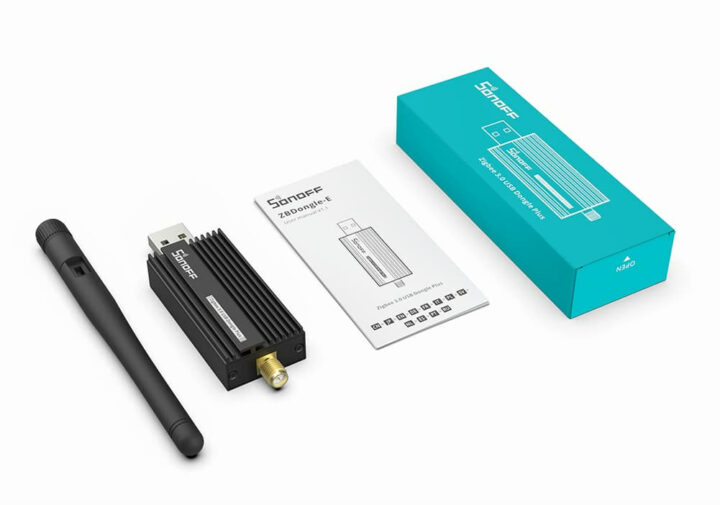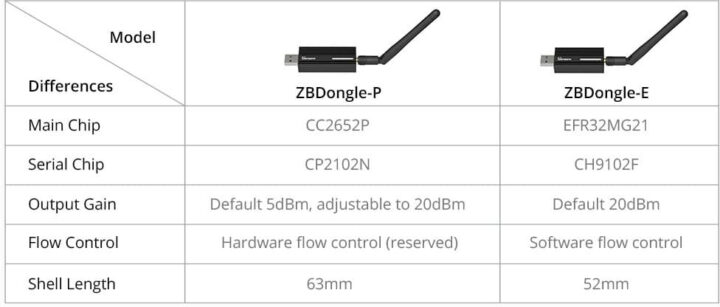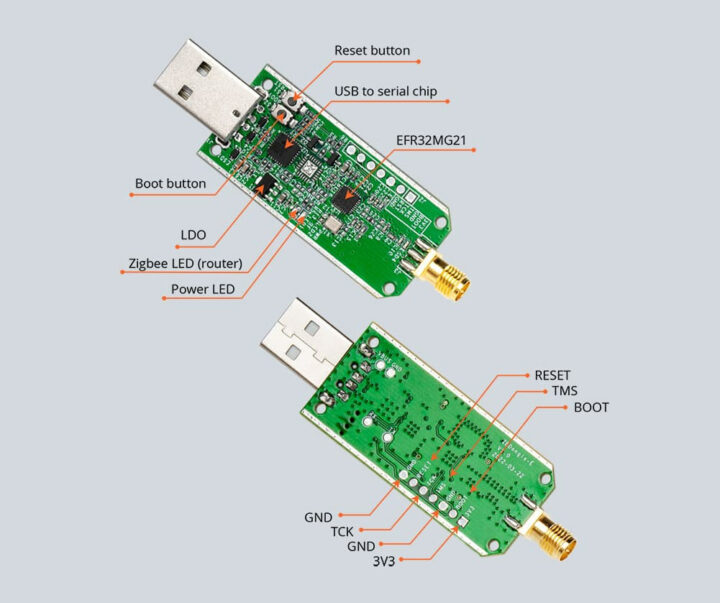ITEAD has just released a new “ZBDongle-E” Zigbee 3.0 USB adapter with Silicon Labs Mighty Gecko EFR32MG21 Arm Cortex-M33 microcontroller with a +20dBm radio for extended range.
The new dongle is an alternative to the popular Texas Instruments CC2652P-based Sonoff Zigbee 3.0 USB Dongle Plus, also known as “ZBDongle-P”, with a more compact design, and many of the same features.
 Sonoff ZBDongle-E specifications:
Sonoff ZBDongle-E specifications:
- Wireless MCU – Silicon Labs EFR32MG21 Arm Cortex-M33 multiprotocol wireless MCU @ 80 MHz with 64KB RAM, 768KB flash, +20 dBm 802.15.4 radio for Zigbee 3.0 and Thread support, and as well as a Bluetooth 5.1 Low Energy radio
- Connectivity – Zigbee 3.0 with SMA antenna connector, +20 dBm output power
- Host interface – USB port with CH9102F USB to TTL chip
- Expansion – 7-pin IO header with programming pins
- Misc – Boot and reset buttons, Zigbee LED, Power LED
- Power Supply – 5V/100mA via USB port, LDO
- Dimensions – 75 x 25.5 x 13.5mm (Aluminum alloy enclosure)
- Weight – N/A
- Temperature Range – -10°C to 40°C
The ZBDongle-E Zigbee 3.0 USB dongle is pre-flashed with Zigbee coordinator firmware based on EZNet 6.10.3 and works out of the box with Home Assistant‘s ZHA integration, Zigbee2MQTT (a.k.a. Z2M – update: EFR32MG21 is not recommended with Z2M, see comments section), IoBroker, OpenHAB’s ZigBee Binding, the Zigbee Plugin for Domoticz, and finally Zigbee Plugin for Jeedom. The Zigbee 3.0 adapter is compatible with ITEAD’s Zigbee router and end devices and should also work with Zigbee 3.0 hardware from third parties.
The Silicon Labs EFR32MG21 microcontroller also happens to be used in the upcoming Home Assistant SkyConnect USB Stick, ITead’s Sonoff ZBBridge and the ZB-GW03 eWeLink Ethernet Zigbee Gateway, so software/firmware should be pretty good for home automation projects. The dongles are used as Zigbee Coordinators by default, but they can be used as a Zigbee Router device if flashed with such firmware instead, and we’ve also been told the OpenThread/Spinel Radio Co-Processor (RCP) firmware would enable the Thread network protocol and support for the Matter standard.

Since the Silicon Lab (ZBDongle-E) and Texas Instruments (ZBDongle-P) Zigbee 3.0 adapters offer different compatibility and price range. ITead will now sell both of these so that DIY users can have more options. The ZBDongle-E is now sold for $19.90 (10% discount with coupon CNXSOFTSONOFF), while the ZBDongle-P is currently out of stock, but used to go for $9.90.
Thanks to Hedda for the tip.

Jean-Luc started CNX Software in 2010 as a part-time endeavor, before quitting his job as a software engineering manager, and starting to write daily news, and reviews full time later in 2011.
Support CNX Software! Donate via cryptocurrencies, become a Patron on Patreon, or purchase goods on Amazon or Aliexpress





